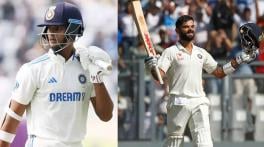Does Imamul Haq deserve the 'parchi' tag — his career in numbers
The statistical evidence in favour of Imamul Haq appears to outweigh the reputation that precedes him.

It’s a recurring theme in everything Pakistan, not just cricket. From the top echelons to the lowest of the pits, nepotism is ingrained in the system.
Why else are ‘family occupations’ a thing? Even if saved for the advantage of readymade inspiration and guidance, too many new generations end up following in the footsteps of old ones. That cannot be a coincidence. Not when politicians breed politicians, government officers breed government officers, and winners breed winners.
Nepotism is real and it runs rampant.
But the puzzling beauty of everything we know is also its random irregularity. Just because a phenomenon is widespread is no guarantee that it must also exist in every single case. Or every case the gen pop so badly wants it to exist in, for the validation of their preconceived notions.
Which brings us to Imam-ul-Haq — the story’s protagonist or antagonist, whichever way you prefer it.
As things currently stand, Imam is thought of as the poster child of nepotism in modern Pakistan. Just the structure and sound of his first name is enough to evoke the memory of a legendary batsman from the past. The shared “ul Haq” in surnames piques the interest. But Misbah also was an ul-Haqer and he wasn’t related so the door on this being a non-case remains ajar.
But a quick wiki check confirms the hunch. Imam is indeed related to Inzamam — the former being the nephew, the latter the uncle. The nepotism alarms go off. The sound so deafening it drowns out everything: the evidence there is and even the evidence there is not.
The preamble fits in here.
It calls for a rational, unemotional, agenda-free review of Imam’s career. And the best way to do that is to give him the number treatment.
Baptism of feathers (avg of 68)
Imam’s ODI career begins on Oct 18, 2017 against the easiest of sides — Sri Lanka — in the easiest of places: UAE. He delivers a 125-ball 100 on debut in a mere 209-run chase. Pakistan outclass Sri Lanka 5-0 in the series.
His first tricky test comes in New Zealand when he was asked to fill in for the injured Fakhar Zaman and open the innings with Azhar Ali. Imam lasts 11 balls, perishes for two runs and doesn’t get another game. For context though, that series every opener not named Fakhar Zaman fails.
Then comes the tour of Zimbabwe where both Imam and Zaman go wild. Imam smashes three centuries in five ODIs, sending his batting average through the roof. But you can argue that against the Lankans and the Zimbabweans, any cricketer that can hold the bat can average 68 an innings. Fair enough.
First real test (avg of 55)
The second phase of Imam’s number story is again set in the dead of the UAE, but this time against better prepared opposition than the Sri Lanka of 2017. Over the seven matches of the Asia Cup 2018 and the bilateral series against the New Zealand, Imam averages 55.
Against India he fails both the times but against Afghanistan and Bangladesh, two deceptively dangerous opponents, he delivers 80 and 83-run knocks. Against the Tigers, he delivered the runs but not the win. It ended Pakistan’s campaign but he was the last-man standing and carried the team on his novice shoulders until he couldn’t.
Braving the South African pace (avg of 54.2)
Imam’s first African tour had been a cakewalk. This one was supposed to be anything but. This was to expose him to the other side of Southern Africa which he hadn’t come across in Bulawayo.
But he flips the script. Against a pace attack featuring scary names such as Dale Steyn and Kagiso Rabada, he doesn’t flinch and averages 54.2 with the bat. He proves his mettle with an 86, a 101 and another 71 in a five-match series. Pakistan lose the series 3-2 but he was the team’s best batsman.
The dip against the Aussies (avg of 21)
Imam’s first dip came in the home series against Australia where he averaged just 21 across three matches. This was a series where his regular partner Zaman was rested. In fact, he also only played three of the five matches — all of which Pakistan lost. In a series Pakistan were clearly more concerned about trying out new players rather than winning, Imam failed.
Sole positive against England (avg of 117)
Pakistan were whitewashed 4-0 by England but it was despite Imam’s contribution rather than because of it. The southpaw averaged 117 across four innings, during which time he was dismissed just twice. In one of those games his 151 had fixed Pakistan with a giant 359-run target. It wasn’t his fault that the bowlers couldn’t defend it.
The underwhelming World Cup (avg of 38)
Quite clearly the most prominent of the dips came at the World Cup 2019 where he averaged 38 despite delivering 50-plus for his career. Before his 100 in the final game against Bangladesh, his average for the tournament actually stood at 29.2 runs per innings, which over seven games was disastrous.
The 100 did not just boost his average into late 30s, it raised his profile too. It got him on the prestigious Lord’s honour board. Not to mention that the parting impression it left on the critics minds was of Imam the century-maker rather than Imam the 29-runs-per-innings scorer.
The verdict
Over the six phases of Imam’s career, he has had two below-par series: one against Australia and the World Cup. His statistics have undoubtedly benefitted from playing Zimbabwes and Sri Lankas in the first few months of his career but since then he has had multiple strong showings against the likes of South Africa and England, not to mention the Asia Cup.
The only real blot on his CV is his trio of failures against India. A total of 19 runs against the neighbours at an average of 6.33 are indefensible. There is more to cricket than just India though, and there is time to wash out that stain.
The statistical proof is enough to conclude that Imam is not in the side because of his uncle, or just because of his uncle. That is not to discount the possibility of him receiving an early push — he may have had. But since then the body of his work could not have been created without him having the game to match the proverbial parchi.
This article originally appeared at The News International and has been reproduced with permission.















Comments